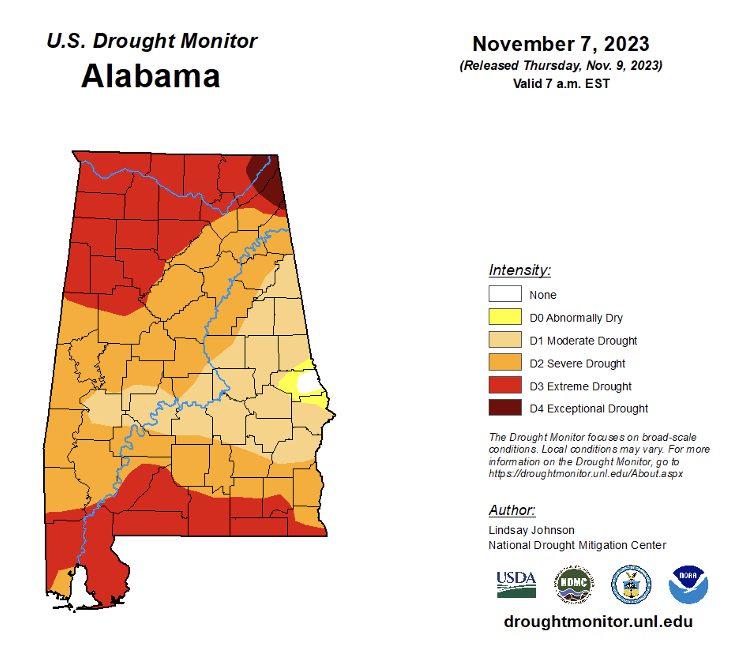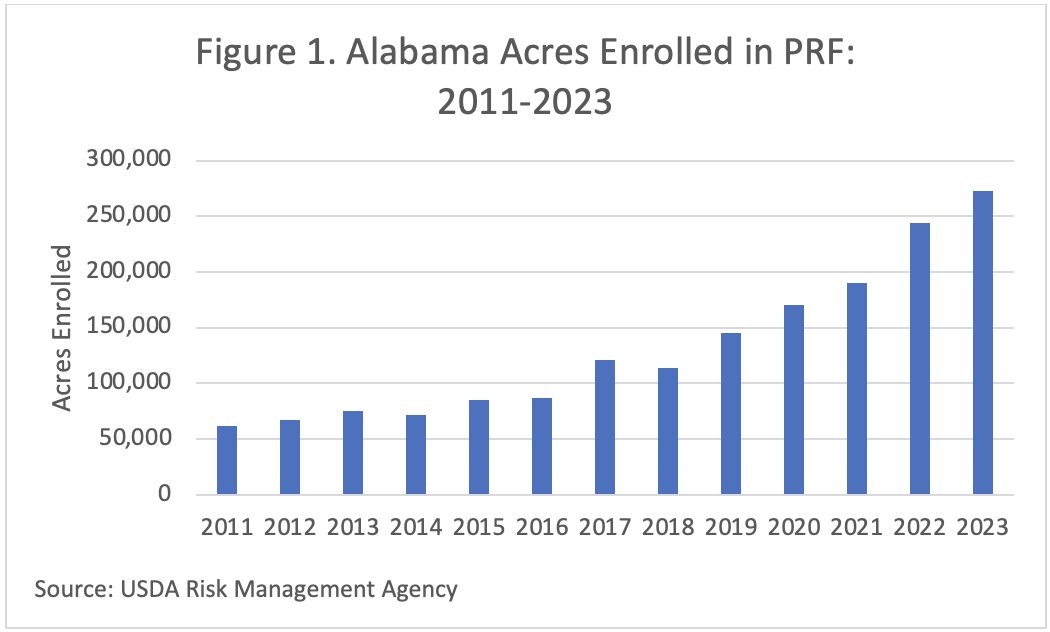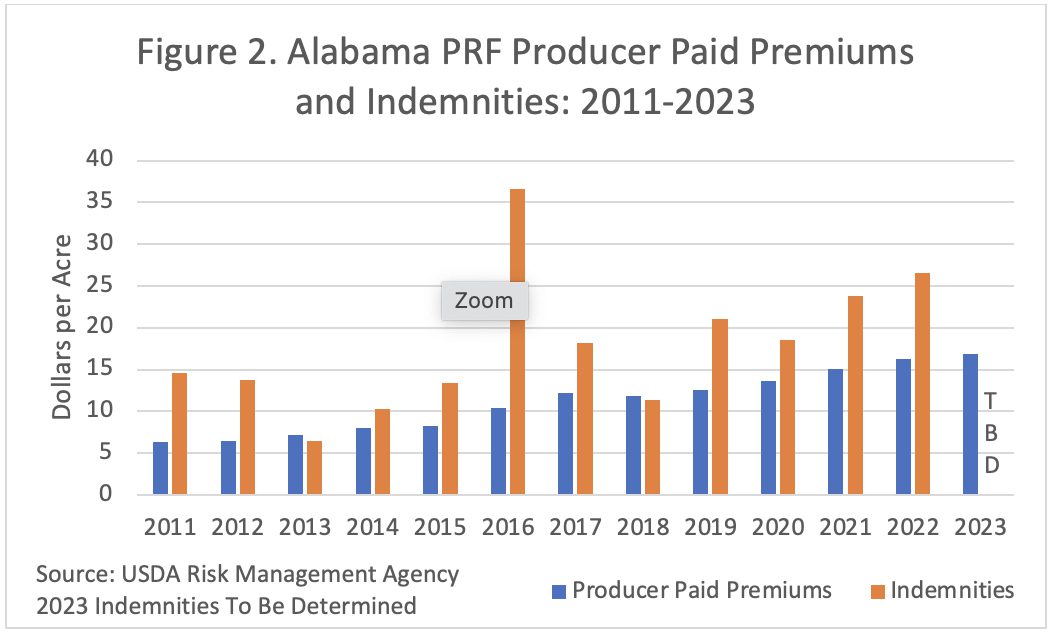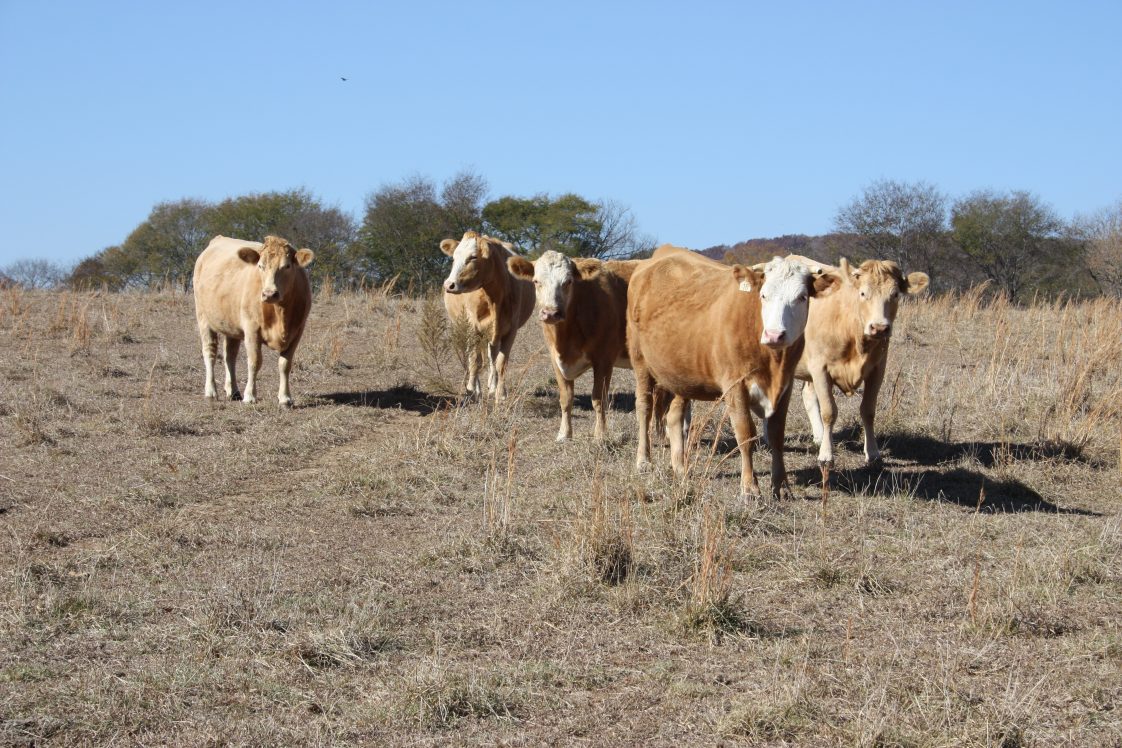Farm Management

Extremely hot, dry conditions persisted in the southeastern United States during the last few months of 2023. The U.S. Drought Monitor released November 9, 2023, showed about half of the Alabama counties at least partially included in D3 Extreme Drought intensity. The extreme northeastern corner of the state was also classified at the highest level of intensity—a D4 Exceptional Drought.
 How the weather affects agricultural producers is a major issue. Land used for the production of hay and forages needs to receive adequate moisture for the growth and maturity of this vital feed for cattle. While weather is out of human control, there are options that producers can use to help minimize the financial impact on agricultural production.
How the weather affects agricultural producers is a major issue. Land used for the production of hay and forages needs to receive adequate moisture for the growth and maturity of this vital feed for cattle. While weather is out of human control, there are options that producers can use to help minimize the financial impact on agricultural production.
The United States Department of Agriculture (USDA) Risk Management Agency (RMA) administers an insurance program targeted to producers of perennial forage for grazing and hay. The Rainfall Index (RI) Pasture, Rangeland, and Forage (PRF) insurance program provides an insurance product that is heavily subsidized and available in every Alabama county. When rainfall is low relative to historical averages, this insurance product will pay indemnities on eligible policies to help producers cover replacement feed costs or lost revenue.
Acreage enrolled in PRF has steadily increased in Alabama, as shown in figure 1. In the program’s early years, slightly more than 60,000 acres were enrolled; however, this has steadily increased over the years. Record enrollment occurred in 2023, with about 270,000 covered acres. However, there is still a lot of opportunity to cover additional pasture acres in the state. According to the 2017 US Census of Agriculture, there were almost 2.3 million acres of pastureland in Alabama, excluding woodland pastured. That means about 12 percent of the total pastureland is enrolled in PRF, providing opportunities for producers to consider this risk management strategy.
Basics of PRF Insurance
 Producers select a grid based on location, and rainfall is measured using the four closest weather stations. Unlike other USDA insurance programs that use the drought monitor, PRF determines covered losses based on a selected guarantee that ranges from 70 to 90 percent of the historical average precipitation from 1948. This is based on a selected two-consecutive-month coverage interval chosen by the producer. When the average rainfall index in the selected grid falls below the guarantee for the 2-month period, then a payment is triggered. The guarantee and coverage period are just two of many different options offered to producers to customize the policy to what best suits their individual operation.
Producers select a grid based on location, and rainfall is measured using the four closest weather stations. Unlike other USDA insurance programs that use the drought monitor, PRF determines covered losses based on a selected guarantee that ranges from 70 to 90 percent of the historical average precipitation from 1948. This is based on a selected two-consecutive-month coverage interval chosen by the producer. When the average rainfall index in the selected grid falls below the guarantee for the 2-month period, then a payment is triggered. The guarantee and coverage period are just two of many different options offered to producers to customize the policy to what best suits their individual operation.
Producers also choose the number of acres to insure, with no set minimum and no requirement to insure all acres. This means that PRF can be an option for even small-scale producers. The intended use needs to be declared as either haying or grazing. A productivity factor is also chosen so producers can cover more or less than the average productivity in the area. RMA has an online decision tool to view historical rainfall averages, choose options, and estimate indemnities.
Subsidized Premiums
 The federal government subsidizes premiums for purchasing PRF coverage. Subsidies range between 51 percent and 59 percent of the overall premium, depending on the coverage level chosen. Given this high level of support, the actual producer-paid premiums in Alabama have been less than indemnities paid on eligible policies in all but 2 of the last 12 years. Figure 2 shows the producer-paid premiums, i.e., after premium subsidies have been deducted and the indemnities paid on all policies sold in Alabama from 2011 to 2022. The only 2 years when indemnities did not exceed premiums paid by producers were in 2013 and 2018. In 9 of the other 10 years, the average dollar-per-acre indemnity www.aces.eduexceeded the average producer-paid premium by more than $6 per acre (excluding 2016 when it was more than $25 per acre). Premiums also do not need to be paid until September, after which early season indemnities may cover those costs. These are statewide averages, and premiums and indemnities will vary by grid and individual coverages.
The federal government subsidizes premiums for purchasing PRF coverage. Subsidies range between 51 percent and 59 percent of the overall premium, depending on the coverage level chosen. Given this high level of support, the actual producer-paid premiums in Alabama have been less than indemnities paid on eligible policies in all but 2 of the last 12 years. Figure 2 shows the producer-paid premiums, i.e., after premium subsidies have been deducted and the indemnities paid on all policies sold in Alabama from 2011 to 2022. The only 2 years when indemnities did not exceed premiums paid by producers were in 2013 and 2018. In 9 of the other 10 years, the average dollar-per-acre indemnity www.aces.eduexceeded the average producer-paid premium by more than $6 per acre (excluding 2016 when it was more than $25 per acre). Premiums also do not need to be paid until September, after which early season indemnities may cover those costs. These are statewide averages, and premiums and indemnities will vary by grid and individual coverages.
Producers should contact an approved insurance provider (AIP) and crop insurance agent to purchase a PRF policy. Find an AIP and crop insurance agent on the RMA website; search for insurance providers. The deadline to enroll in PRF is December 1. Additional and updated information on the PRF program can also be found on the Alabama Cooperative Extension System website at www.aces.edu.
 Adam Rabinowitz, Extension Specialist, Assistant Professor, Agricultural Economics and Rural Sociology, Auburn University.
Adam Rabinowitz, Extension Specialist, Assistant Professor, Agricultural Economics and Rural Sociology, Auburn University.
New April 2024, Using Insurance to Manage Drought Risk in Hay & Forage Production, ANR-3044

